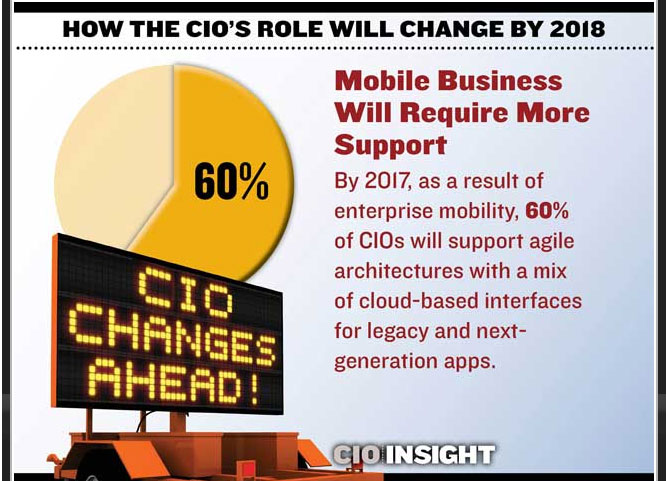Comprehensive Guide to Enterprise IT Service Automation
IT support automation uses software workflows, rule engines, AI/ML, and integrations to automate...
The focus and responsibilities of the CIO position are expected to evolve significantly over the next few years, as IT adapts to the latest once-in-a-generation change.

The focus and responsibilities of the CIO position are expected to evolve significantly over the next few years, as IT adapts to the latest once-in-a-generation change.
CIOs will be challenged to innovate and be strategic planning partners with other business leaders, while dealing with increased cyber-security threats and information architecture platform changes, in an environment of skills shortages and anemic budgets—among other changes.
Those are a few of the conclusions reported on CIO Insight from a recent IDC study, Worldwide CIO Agenda 2014 Top 10 Predictions. The report describes the new challenges CIOs are facing and provides recommendations for how CIOs can transform their organizations over the next few years to adapt to these developments.
Three trends in particular—pertaining to agility, mobility, cloud computing, social networks, and service planning—deserve a closer examination.
“By 2017, as a result of enterprise mobility, 60% of CIOs will support agile architectures with a mix of cloud-based interfaces for legacy and next-generation apps.”
As noted here previously, mobile device management and mobilizing business processes is a high priority in a majority of enterprises this year. But not every business process needs to be mobilized, and not all of those that do have the same urgency. The best approach to supporting mobile workers is an agile model; determine which processes are most vital to and common among mobile users, redesign those processes to provide a delightful experience for mobile users, then move on to the next prioritized set.
In addition, as the prediction above acknowledges, most enterprises have significant investments in legacy control and management applications. Mobile users increasingly need the ability to view, add, delete, and change information in these systems. Proving mobile access to legacy applications and data needn’t mean a disruptive and expensive “rip and replace” approach.
Instead, build a simplified, mobile-friendly web interface that enables users to access and interact with data in legacy systems. This “leverage and extend” approach is far less costly and time-consuming, and can be rolled out gradually, as with mobile process redesign. Forrester Research describes this as integrating “legacy ‘systems of record’ with newer, cloud / mobile / web-based ‘systems of engagement.'”
“80% of CIOs in consumer businesses will integrate IT with public social networks by 2015 in order to meet the needs of young and mobile customers.”
Possibly—though the notion that public social networks are the best venue for IT (or other business service) integration is certainly debatable.
Just as most people use different social networks for different types of interaction (e.g., LinkedIn for professional networking, Facebook for friends and family, Twitter for news, etc.), business communications aren’t monolithic either. Projects and topics within a business are typically of most interest to a discrete, defined group of employees.
It’s likely therefore that business application vendors will build contextual social capabilities into existing systems, so that, for example, the P&L statement can be discussed within the accounting system, while performance reviews can be commented on (with proper access rights, of course) from within the HR management software, and IT service metric trends can generate social interaction within a business value dashboard.
“IDC expects 60% of CIOs to recognize the importance of developing a fully functional enterprise architecture linked to service development and planning, but says less than 40% will deploy that architecture effectively.”
A key component of an “enterprise architecture linked to service development and planning” is a business service catalog that enables business process owners to map out, test and deploy their own process workflows in conjunction with IT, but with minimal technical assistance.
This approach enables those with the most knowledge of business processes to redesign those processes from the user perspective, and teams to develop processes that cross functional lines (e.g., onboarding a new employee). Employees, meanwhile, are provided with one central portal from which they can request any type of service, resource, or product needed to do their jobs, and check on the status of pending requests, at any time from any device.
As the role of the CIO evolves, some disruption will be inevitable. But using tools that leverage existing technologies as much as possible minimizes business interruption. Using those tools to enable automated self-service increases convenience for users while reducing costs. And taking an agile approach to service redesign, and the technology needed to support automated, enterprise-wide service delivery, can help avoid unnecessary jolts and smooth the path (somewhat at least) to becoming a next-generation CIO.
Next steps:

IT support automation uses software workflows, rule engines, AI/ML, and integrations to automate...

Business process reimagined is the strategic renewal of how work gets done by combining modern digital...

You've probably noticed (what we're calling) the "logo-swap test" lately: all the AI ads in market sound...